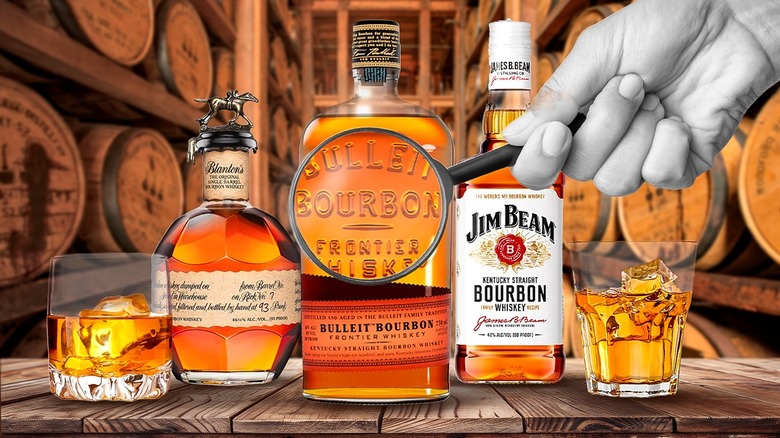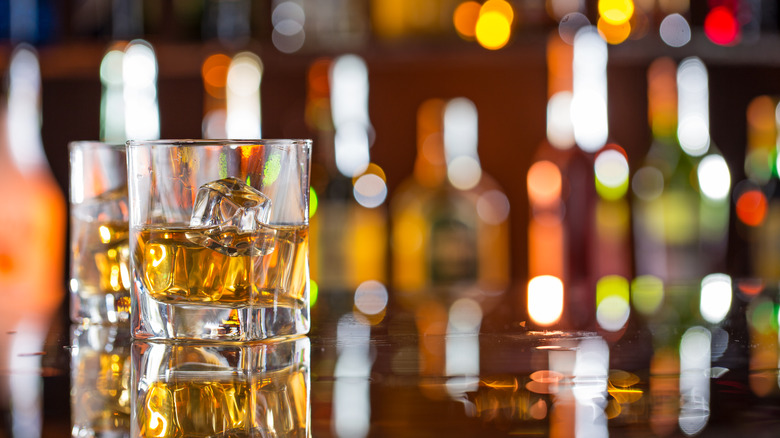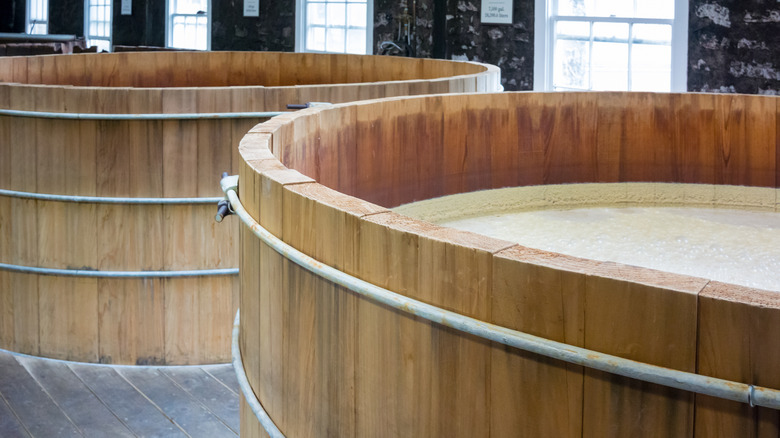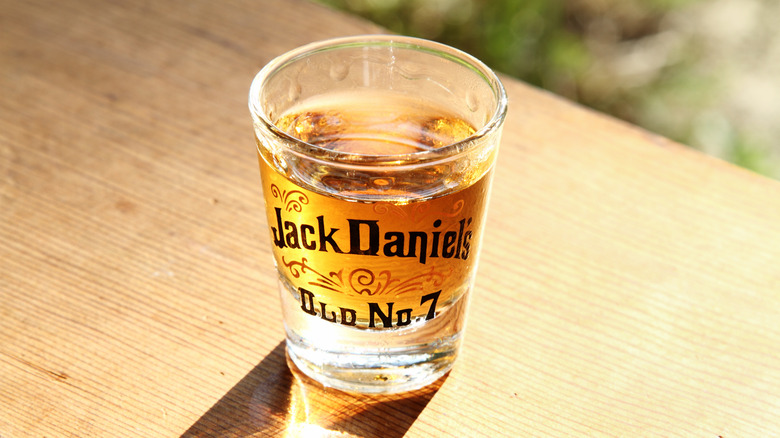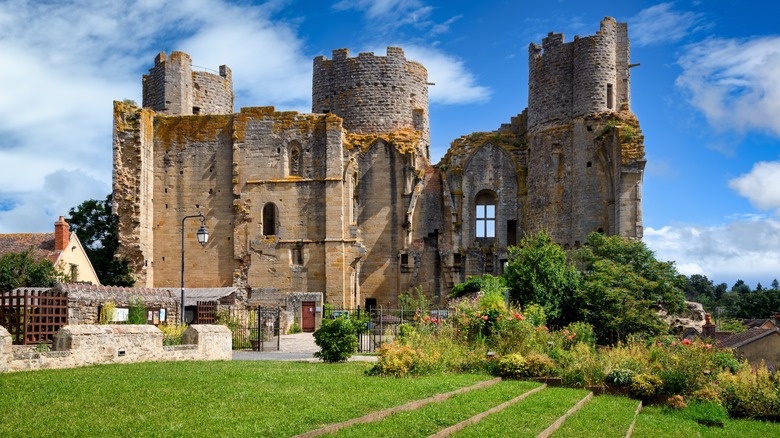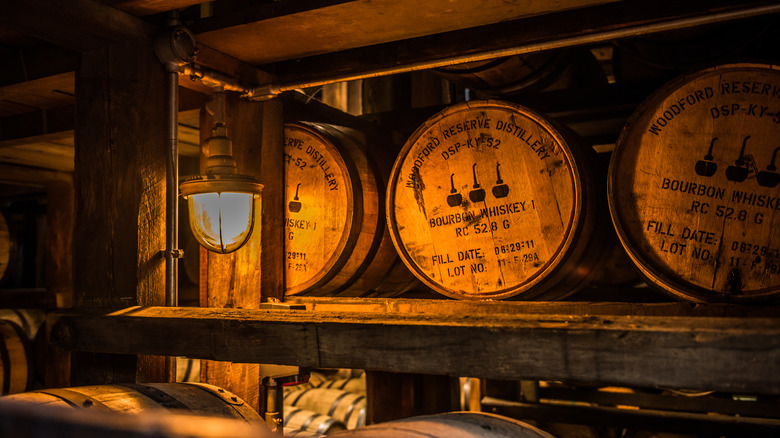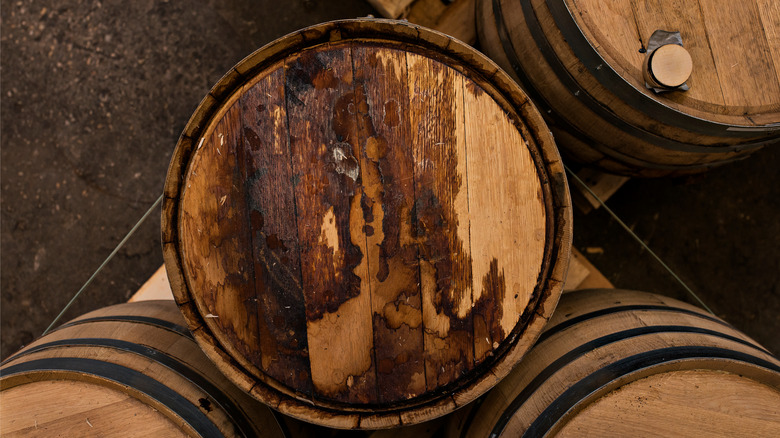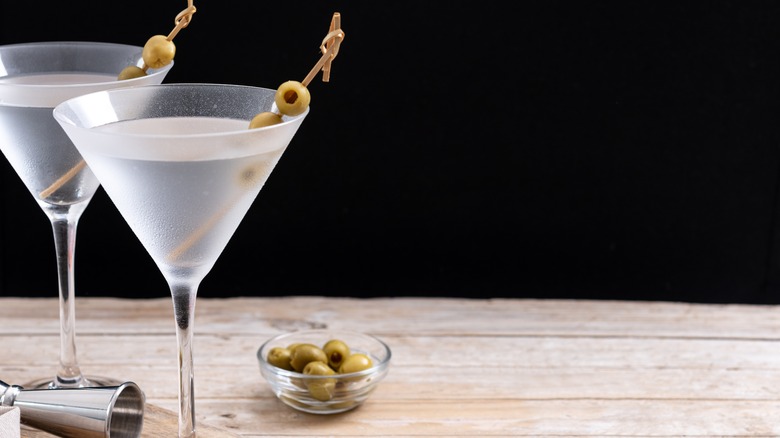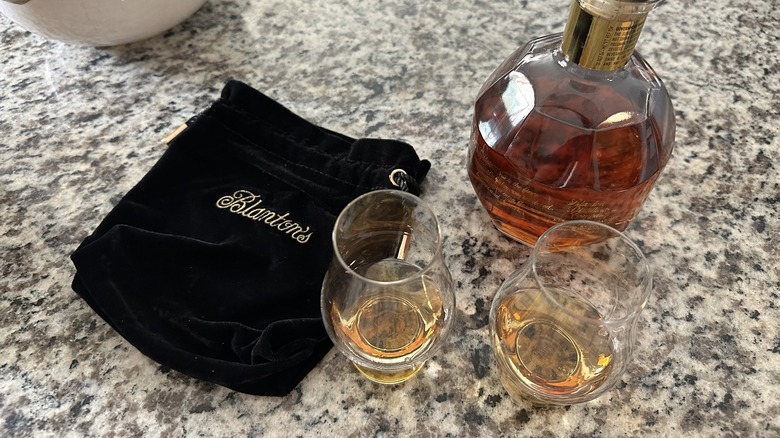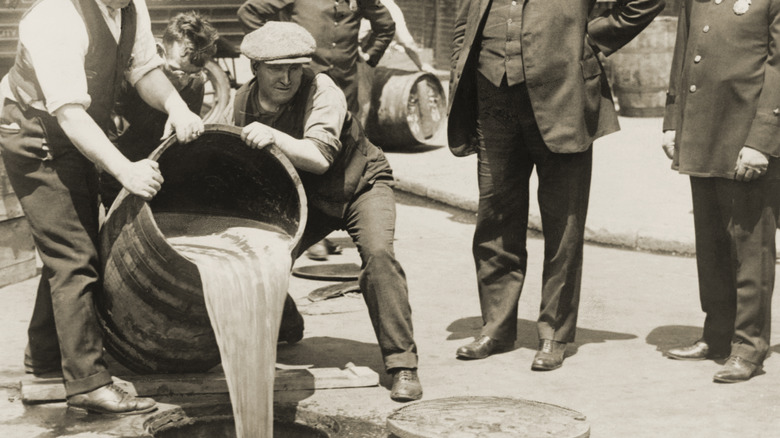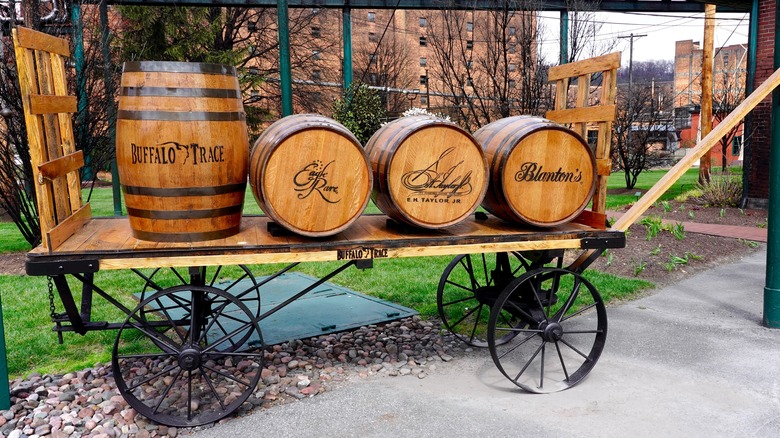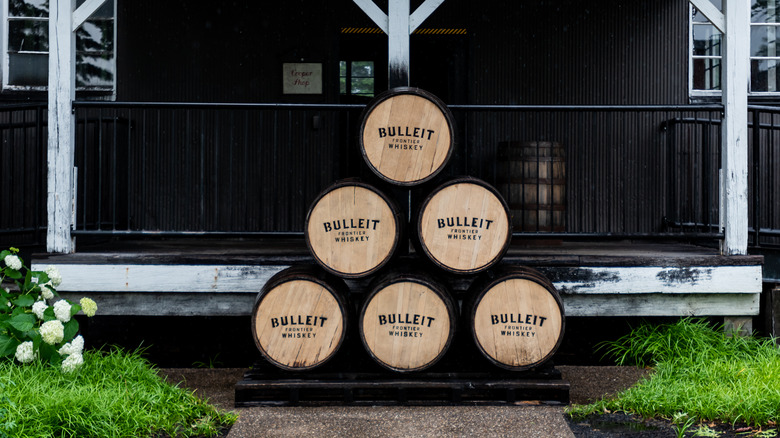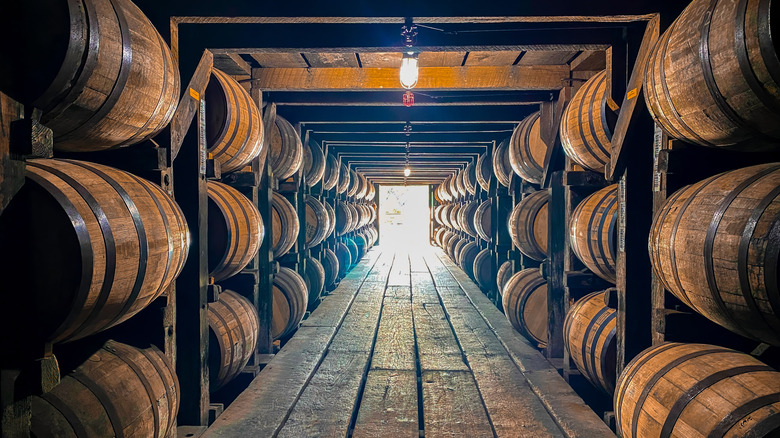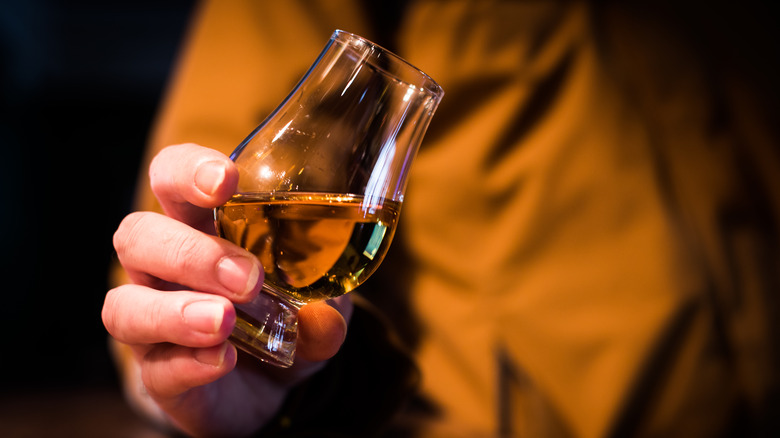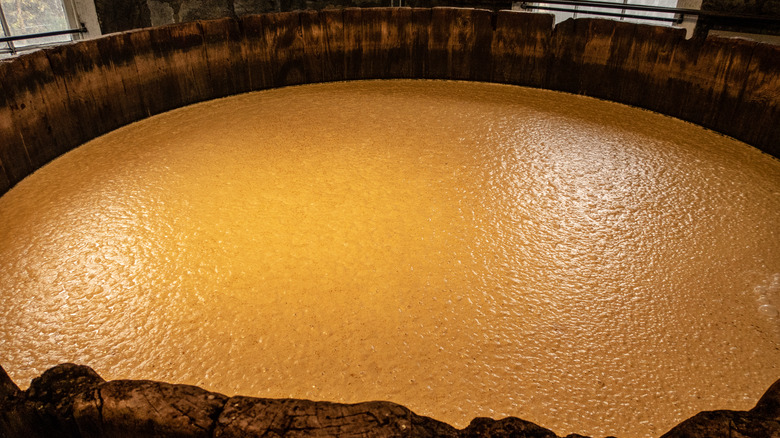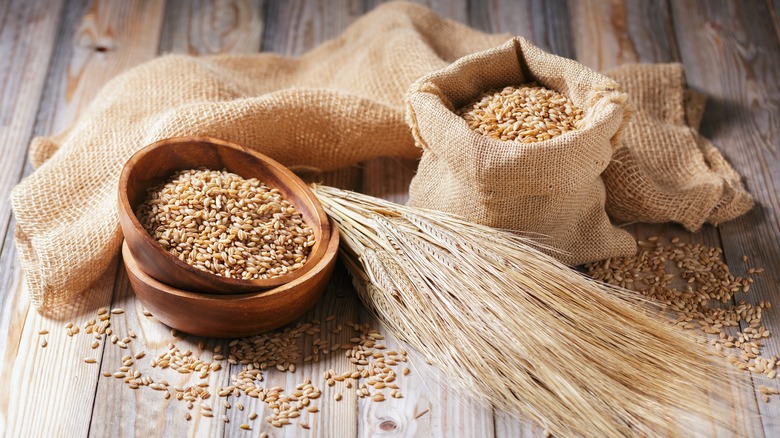15 Facts About Bourbon You Probably Didn't Know
Everyone knows what bourbon is — or do they? Most will correctly identify it as American whiskey, but even that doesn't tell the whole story. Bourbon is a legally defined term with its own set of special rules to follow. However, there are also other aspects of this spirit that some people may presume to be rules, but aren't. While the definition of bourbon may seem simple on the surface, there are plenty of interesting intricacies that help to make it special.
I've been drinking bourbon for many years now, have enjoyed countless bottles, and I've picked up plenty of interesting facts along the way. When you add that to my distillery visits and conversations with industry experts, I'm well-placed to enlighten budding bourbon enthusiasts with facts about bourbon you probably don't know. Even if you fancy yourself as somewhat of a bourbon expert, there should be some surprising tidbits here for you. So let's get started with our journey through the weird and wonderful world of bourbon.
1. There is no minimum aging
There are quite a few rules around what is classed as bourbon that I'll discuss throughout this piece. However, age is not mentioned at all. As long as it meets all the criteria, the spirit can be bottled straight away and marketed as bourbon. This is a surprise for many people but there are a couple of things to note. Firstly, there seems to be an unwritten rule that unaged bourbon isn't marketed as such. A good example of this is white whiskey brands like Buffalo Trace White Dog which is an unaged version of its flagship Buffalo Trace Bourbon. Secondly, good bourbon needs to be aged for a few years minimum, and most distillers will do this.
This leads us to the designation of "straight bourbon". If you see that used on the bottle instead of just "bourbon," you can be confident the whiskey has been aged for at least two years. Similarly, "bottled-in-bond" bourbon has to be aged for at least four years. Therefore if you see either of these terms, you can rest assured the bottle has at least received a decent amount of aging. Usually, the only time you'll see just "bourbon" on the bottle is with the cheap bottles that can often be found on the bottom shelf.
2. Most big distilleries have an exclusive yeast strain
Several ingredients go into creating a bourbon. One of the most unique is the yeast strain. During fermentation, the yeast consumes the sugars in the mash and produces alcohol. This contributes to the final flavor and distilleries are highly protective of the yeast they use. Many use what's called a proprietary strain, which is a yeast unique to them. Four Roses uses five such strains and this helps to ensure consistency and creates a signature taste.
These yeasts can be a closely guarded secret, passing from one generation to another. This was shown indirectly when Paul and Stephen Beam managed to reclaim yeast DNA from a jug found in a museum when creating their Yellowstone Select bourbon. This was a strain that had been used by their great-grandfather. Each strain has distinctive characteristics which is why two bourbons with similar ingredients can taste so different. The yeast is the understated hero of bourbon production as you can't make alcohol without it.
3. Jack Daniel's is technically bourbon
Jack Daniel's doesn't like people knowing this, but Old No. 7 is technically bourbon. We've already looked at a few of the rules but this famous spirit meets all the legal criteria to be called bourbon. It is made in the U.S., contains at least 51% corn, is aged in new charred oak barrels, is distilled to no more than 160 proof, and is bottled at a proof of at least 80. Why doesn't it use the bourbon title? Simply put, it doesn't have to and prefers to brand itself as Tennessee whiskey.
There are many great Tennessee whiskeys out there and they need to go through an extra step called the Lincoln County Process, which consists of charcoal filtering. This extra step helps to give it a smooth and mellow flavor, which can help to set Tennessee whiskeys apart. While this process is required for the Tennessee whiskey designation, it does not affect whether or not a whiskey can call itself bourbon. The Jack Daniel's example shows how the term "bourbon" isn't just about the law, it's also about branding and tradition. While you don't have to call your drink bourbon if it meets all the rules, you can only call your drink bourbon if it does.
4. It's indirectly named after the French royal family
Bourbon is a quintessentially American drink. After all, it can only be advertised as bourbon if it was made in the country. However, the name of the spirit comes from French origins. In the late 18th century, settlers began distilling whiskey in what became Kentucky. This was in a region called Bourbon County. It's almost certain the spirit was named after the county, which makes a lot of sense. The county was named in honor of the French royal family, The House of Bourbon.
This was done as a tribute to French support during the American Revolution. The Bourbon family ruled France for over two centuries but their name is now synonymous with American culture. There is no evidence to suggest the Bourbon family had any direct connection to the liquor. So while the spirit isn't directly named after the family, it is still a nod to the history of the region and the two nations.
5. Weather affects the taste
Once the bourbon is distilled, the barrel in which it's stored notoriously has a strong influence on the final flavor. A lesser-known fact is that so do atmospheric conditions. Some spirits are aged in temperature-controlled environments, but bourbon usually isn't. Instead, it is stored in warehouses (called rickhouses) where it is exposed to the elements. In the warmer months, bourbon can seep more into the wood and absorb more of its flavor. In the colder months, the bourbon will contract, and this interaction will be lower.
The location in the rickhouses will also impact the flavor. Temperature influences aging, with warm weather speeding up the aging process. This means the position of the barrel can also have an impact, as barrels stored higher are usually exposed to slightly higher temperatures as well as more significant fluctuations. These natural variations mean that every batch of bourbon is unique. Some distilleries will move barrels around to ensure consistency, whereas others are happy to celebrate these differences.
6. There is an angel's and devil's share
In the bourbon-making process, there is what is poetically called the "angel's share" and the "devil's share". This is because the liquid you put into a barrel isn't the same amount you get out. The angel's share refers to the portion of the bourbon that evaporates through the porous wood of the barrel. With this water going up to the heavens, it was once joked this was the angels taking their cut of the spirit.
The devil's share is the loss of bourbon in another way. It refers to the bourbon that gets absorbed into the wood and isn't released when the barrel is emptied. It stays locked in the barrel staves but can be released, which is what Jim Beam has done with its Devil's Cut bourbon. It's due to these losses that the bourbon that comes out of the barrel is of a higher proof than when it went in, as the water loss makes it more concentrated. Most whiskeys are then cut with water to bring them back to a more palatable proof. However, there are also many barrel-proof bourbons out there that deliver the spirit exactly as it comes out of the barrel.
7. Bourbon had a major slump
These days it's hard to imagine a time when bourbon was uncool. Yet sales started to plateau at the end of the '60s, fall in the '70s, and slump in the '80s. The '90s weren't much better, and it wasn't until the 21st century that bourbon started to soar again. A few factors contributed to the slump, with the main culprit being the rise in popularity of white spirits such as vodka and tequila. There was also a distinctive lack of innovation in the bourbon industry and most offerings were cheap and quite rough. This led to decreased sales and distillery closures. The revival started when bourbon cleaned up its image.
Quality improved and small-batch and single-barrel bourbons started to gain traction. The resurgence was helped by foreign markets such as Japan before America's spirit was back on center stage in its homeland. If it wasn't for bourbon legends such as Elmer T. Lee who created Blanton's Single Barrel, the whiskey industry today could be vastly different. Bourbon could have just been a cheap whiskey for when you couldn't enjoy Japanese or Scotch spirits. Instead, it proudly stands among them for anyone who loves this fabled spirit.
8. Some bourbons are only sold outside the U.S.
You may see the title of this section and ask yourself, "Why?" As we know, bourbon has to be made in the U.S. — so why are some products only sold abroad? There are a few reasons for this, but it's linked to the bourbon slump we just mentioned. Japan had an interest in high-end bourbon before Americans did. Many bourbons exclusively sold overseas are varieties of Blanton's, which was the first single-barrel whisky made and became hugely popular in Japan.
There are likely a few other reasons for this exclusivity. Knowing that a bourbon is only sold abroad can give it a sense of prestige. Americans get a buzz from getting the whiskey on their travels, and native consumers will enjoy the fact that they are enjoying exclusive bourbon. Regulatory differences can cause differences too. For example, Buffalo Trace in the U.S. is sold at 90 proof but in the U.K., that is reduced to 80 due to higher alcohol taxes.
9. Bourbon has been sold as medicine
Prohibition decimated the bourbon industry, but a legal loophole allowed some distilleries to survive. Under the Volstead Act, doctors were able to prescribe medicinal whiskey to patients for a variety of reasons. These included headaches, anxiety, and even the flu. This created a situation where pharmacies were able to sell whiskey to anyone who had a prescription. This loophole kept the bourbon industry alive and allowed several distilleries to stay open until Prohibition was repealed in 1933. While it was in effect, patients could claim a pint of whiskey every 10 days for their apparent ailment.
Many took advantage of this loophole with speakeasies pretending to be pharmacies, and consumers no doubt making up illnesses to get their hands on a pint. It was one of several challenges the industry has faced, including the slump we've just talked about. Thankfully, these days you don't need a prescription to get a bottle. Medicine has advanced to much better treatments and now we can all enjoy bourbon for the sheer pleasure of it.
10. Many bourbons come from the same distillers
If you stand before a bourbon shelf in a liquor store, you'll be greeted with a vast range of brands. What some don't know is that many of them come from the same distillery. Three of the biggest players in this respect are Buffalo Trace, Jim Beam, and Heaven Hill. For example, Buffalo Trace (along with its flagship bottle) also produces budget brands such as Old Charter and Benchmark, as well as revered bottles like Eagle Rare and Van Winkle. Heaven Hill has an equally impressive whiskey roster with Elijah Craig, Henry McKenna, and Old Fitzgerald, among others.
Through different aging, production methods, and ingredients, all of these whiskeys can taste different despite being made in the same place. Added to this, some independent brands will source bourbon from larger distilleries, age it, and then bottle it under its own label. Due to this, it's a good idea to check the history of what you're buying before you head to the checkout. While there is nothing wrong with any of the above, it's good to know exactly where your bourbon came from.
11. Kentucky has more barrels than people
Where did your whiskey come from? Well, the answer to that is probably Kentucky. There's a claim that 95% of bourbon is made in the state, but that is suspiciously high and disputed by some. Whatever the real figure is, it will still be very high. Kentucky will always be the home of bourbon. And with this spirit now being enjoyed globally, it's perhaps not surprising that the state has more barrels than people. In fact, it's estimated to be well over twice as many.
The number of barrels in the state is around the 12 million mark, with the population of Kentucky being just over 4.5 million. Despite this, bourbon doesn't need to be made there – many great bourbons aren't produced in Kentucky. If you're new to bourbon, the Bluegrass State can satisfy your thirst for a long time to come. But sooner or later, it may be a good idea to see what other states have to offer.
12. All the color comes from the barrel
If you pour a glass of well-aged bourbon into your favorite whiskey glass, you'll notice that it's usually a stunning amber color. Given the number of artificial ingredients that are added to many of our food and drinks, it wouldn't be a bad assumption to think the color has been altered. Not only is this not true, but all of the color comes from the barrel during aging. Artificial additions are not allowed under the strict rules for adding color to bourbon.
When distilled, the liquid is completely clear, which is often referred to as "white dog" or "moonshine". It will then start to get its color as it interacts with the charred oak barrels. The longer a bourbon ages, the more complex the color becomes. There are exceptions to this rule, but young bourbon is usually light gold in color, with maturely aged bourbon having a dark amber hue. When you next pour yourself a glass, you can be content that what you are tasting is 100% natural.
13. It has some unique jargon
We've already looked at some great bourbon terms here such as white dog, Lincoln County Process, bottled-in-bond, angel's/devil's share, and rickhouses, but that is far from all. What do we mean when we're looking at a bourbon's legs? Well, that's the liquid that clings to the sides when you tip your bourbon glass. Doing this can indicate its viscosity and mouthfeel. There are also confusing terms such as distiller's beer and low wine. The former is the name for the fermented grains before distillation, and the latter is the liquid collected from the first distillation, which is a lower proof than finished bourbon.
After distillation, the spirit is separated into three parts with the start and the end of the run being seen as lower quality. These three stages are called the head, the heart, and the tail. It's only the heart that will be barreled. Our final term on this whistle-stop tour is "cutting". This is when the high-proof bourbon is "cut" with water to lower its proof.
14. There is no right way to make it
It'd be easy to assume the making of bourbon was sacrosanct. With it being such a traditional drink, surely there is only one right way to make it? While the science of fermenting sugars can't change, that couldn't be further from the truth. As long as they're following the rules of bourbon, it's entirely up to a distiller as to how they get there. The process allows for a great deal of creativity that leads to a wonderful variety of bourbons.
Along with the difference in ingredients, there can be a difference in the material and shape of fermentation tanks, the use of pot or column stills, different number of times the spirit is distilled, and also different filtering methods. All of these can have a significant influence on the taste. Then you get to the barreling where different types of oak, storage conditions, and aging will all play their part in the final flavor. For bourbon enthusiasts, this variety gives you plenty to explore. It can also help you understand how some bourbons, even from the same distillery, can have vastly different flavor profiles.
15. One grain isn't used for taste
As we know, bourbon needs to be made from at least 51% of corn in the mash bill. However, exactly how much corn is used above this figure is up to the distiller. Added to this, most will then add either rye or wheat for its flavor, sometimes both. Along with this, another ingredient is used, partly because it's required. Malted barley plays an important role in the taste, but the reason it has to be used is because of its enzymes. These enzymes in malted barley convert starch in the grains into fermentable sugars.
The yeast then converts these sugars into alcohol. Without malted barley, the fermentation would be inefficient with not enough alcohol produced. Malted barley can give a nuttier and smokier taste; therefore, some distillers use more than is required purely for fermentation. This means that the grain isn't always used in the same percentage, but usually accounts for 5% to 12% of the overall mash bill. Single malt Scotch whisky, on the other hand, doesn't need to worry about this issue, as that type of whisky is made from 100% barley.
